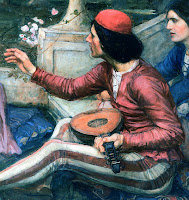Judul : Adonis from Fulham
link : Adonis from Fulham
Adonis from Fulham
In 2009, London's Royal Academy put on an exhibition called J.W.Waterhouse: The Modern Pre-Raphaelite. I went not once, not twice, but thrice. I was working on a book about the most beautiful boy in the Roman Empire in the year AD 96.
 |
| The Siren c. 1900 |
I was so inspired that I went home an wrote an ode about Orpheus called Thracian O.
That almost never happens. I rarely write Odes.
But that is what great art does. It inspires you.
Ovid inspired Waterhouse and Waterhouse inspired me.
When I was studying Classics at Cambridge, I had the poster of Hylas and the Nymphs on my bedroom wall. I loved the fact that Waterhouse seems to have used the same girl model for all the water nymphs. He only deepened or lightened the chestnut tint of the hair. It makes them look like divine clones.
 |
| did the same girl pose for all the water nymphs in Hylas and the Nymphs? |
But as I was walking around the Royal Academy exhibition, studying the beautiful young men in the paintings, I noticed that they all looked similar, too. Adonis, Narcissus, Hylas... even the doomed young sailor in Waterhouse's painting of The Siren.
Could it be that the same male model posed for all of them?
If so, who was he? I wanted to know. A Google search quickly took me to this excellent article by art historian Scott Thomas Buckle. While looking through some old sketchbooks in the V&A, he found a notebook with the names of some of Waterhouse's models. On the top of one page was the sketch of a young man and the notes: Harry Beresford, 19 St Olafs Rd, Fulham, SW, age 16 June 1896... dark hair
 |
| One of J.W. Waterhouse's sketchbooks |
Scott Thomas Buckle did a bit of sleuthing and found an 'artist's model' aged 21 by that name living at that address in the 1901 census, so it all fit perfectly. Young Harry was living with his 42-year-old widowed mother. Buckle thinks Harry might have been of Italian descent like several other Italian artists' models in Fulham.
 |
| Harry Beresford & flipped sailor |
There is a stern warning in the form of a small print note about Hylas & the Nymphs in The Royal Academy Catalogue: It is dangerous to speculate on the models for Waterhouse's figures; not only did he generalise and idealise the features of his models; so that the resulting figures conform to a small number of types, but he may also have used his well-trained visual memory to import reminiscences of favourite types into drawings made from other models.
 |
| St. Olaf's Rd, Fulham, London |
Instead of having a small number of types, might not Waterhouse have had a small number of favourite models?
So I am going to blithely ignore that caveat and claim that Waterhouse liked Harry Beresford so much that he used him over and over. Without any expertise on the subject, I choose to believe that just over a hundred years ago a beautiful Adonis/Narcissus/Hylas/Orpheus lived in Fulham, just a few miles from where I am sitting now.
 |
| The Decameron 1916 |
One evening last week I did a mini-pilgrimage, to see if there was a blue plaque (a kind of historical marker put on houses where famous people have lived). I found a long street of post-Victorian apartment blocks. Not only was there no blue plaque, but Harry's house was no longer there. His street had been redeveloped, probably in the period between WWI and WWII.
I like to think that maybe Harry posed for the man with the lute in this 1916 painting called The Decameron (right). If it was Harry, he would have been 36 years old. It would mean that he collaborated with Waterhouse for twenty years, off and on, right up to the end.
J.W. Waterhouse died in 1917, a year after The Decameron was painted.
But what happened to Harry Beresford, the Adonis of Fulham? I would love to know.
P.S. You can see my blogs about some of Waterhouse's other paintings:
Adonis, Ariadne, Circe, Hylas, Narcissus, Odysseus and Orpheus.
P.P.S. I know much more about the Greeks and Romans than I do about J.W. Waterhouse. I write The Roman Mysteries, a series of history mystery books aimed at children aged 9+, especially those studying Romans and/or Greek Myths. The glossy BBC Roman Mysteries TV series did adaptations of some of these books. The DVDs are available in the UK and Europe. My new Roman Quests feature the boy as beautiful as Adonis and his identical twin.
Demikianlah Artikel Adonis from Fulham
Sekianlah artikel Adonis from Fulham kali ini, mudah-mudahan bisa memberi manfaat untuk anda semua. baiklah, sampai jumpa di postingan artikel lainnya.
Anda sekarang membaca artikel Adonis from Fulham dengan alamat link Sapiens




